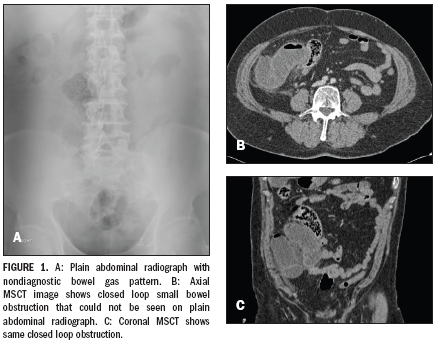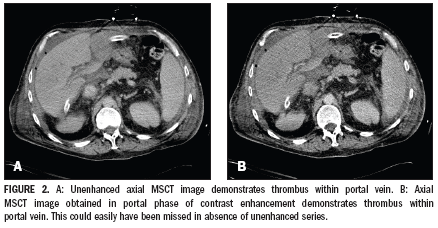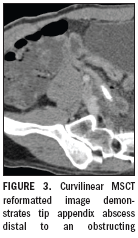Patient-specific approach assists in acute abdomen
The term “acute abdomen” refers to the sudden onset of severe abdominal pain requiring emergency medical or surgical management.
The term “acute abdomen” refers to the sudden onset of severe abdominal pain requiring emergency medical or surgical management. It is one of the most common reasons for presentation at the emergency department.
The potential causes are numerous. A review of 10,682 patients presenting with acute abdomen found that 28% had appendicitis, 9.7% cholecystitis, 4.1% small bowel obstruction, 4% a gynecologic disorder, 2.9% pancreatitis, 2.9% renal colic, 2.5% peptic ulcer disease, 1.5% cancer, 1.5% diverticular disease, and 9% had a selection of less common conditions.1 One third of patients did not receive a positive diagnosis.
Subsequent patient management depends on the diagnosis. A rapid and accurate diagnosis is essential if the patient is to be referred promptly to the appropriate clinical team and to minimize morbidity and mortality. Physical examination and laboratory investigations are often nonspecific. Clinical findings may be equivocal or misleading in up to 50% of patients with blunt abdominal trauma.2,3 Imaging, consequently, plays a vital role.
Plain-film radiography, ultrasound, and CT are all used frequently in the acute situation. A sound knowledge of the advantages and potential pitfalls associated with the choice of investigation, the applied technique, and image interpretation is crucial.
INVESTIGATIVE OPTIONS
The role of the abdominal radiograph is limited. The images are rarely diagnostic and are easily misinterpreted (Figure 1). One study evaluating 871 patients with abdominal pain reported that plain-film x-rays were interpreted as nonspecific in 588 cases (68%), normal in 200 (23%), and abnormal in 83 (10%). Abdominal radiography had 0% sensitivity for appendicitis, pyelonephritis, pancreatitis, and diverticulitis.4

Radiography is, despite this, often the preliminary imaging investigation in the emergency department. It is essential that radiologists and emergency clinicians maintain their interpretive skills while this practice continues. Important clinical findings, such as pneumoperitoneum, pneumobilia, portal venous gas, small and large bowel obstruction, and intramural gas, should not be missed.
CT is widely regarded as the imaging technique of choice for most patients presenting with an acute abdomen.5-8 The limitations of plain-film radiography and ultrasound, coupled with the advent of multislice CT (MSCT), have facilitated this. CT provides a comprehensive review of the abdomen and is not limited by the presence of bowel gas and/or fat.
MSCT systems have enabled faster and superior evaluation of the acute abdomen. Greater volume coverage and thinner slice acquisition have been achieved without significant increases to patients' radiation burden.6,8 Such advances in CT technology have enabled images to be acquired in multiple phases with submillimeter resolution. The routine use of isotropic, multiplanar reconstructions at dedicated CT workstations is also improving the accuracy of MSCT and speeding interpretation. This may be particularly useful when evaluating tubular structures, such as bowel or blood vessels.6
It is not surprising, given these advances in CT, that ultrasound is losing ground in the evaluation of the acute abdomen. Ultrasound still retains some advantages over CT, though. No ionizing radiation is involved in examinations, spatial resolution is high, and tests can be performed at the bedside. Ultrasound is a fundamental tool in examinations of the gallbladder, investigations of the appendix in children and women of child-bearing age, and when imaging the female reproductive organs.
Focused assessment with sonography for trauma (FAST) is used as a screening tool in the evaluation of hemoperitoneum following blunt abdominal trauma. FAST has a high specificity and sensitivity in the right hands. Interaction between the operator and the patient can improve the relevance of searches. Practitioners can also correlate the area of maximum tenderness or a palpable mass with the ultrasound findings.9
FIRST-CLASS TECHNIQUE
Whatever investigation is chosen, it is imperative that it be performed properly. Hemidiaphragms and hernial orifices must be included on plain abdominal radiographs. High-quality images are a prerequisite for detecting subtle abnormalities. Overreliance on plain abdominal radiographs should be avoided because of their low specificity and sensitivity. If a plain abdominal radiograph is reported to be normal but there is clinical concern, further imaging should be performed.
A number of factors influence the diagnostic yield of MSCT. Patient preparation, imaging technique, and protocol selection should be customized to suit each patient. Accurate clinical information is essential, yet clinicians often omit fundamental details. The working diagnosis will guide the use of oral, intravenous, and rectal contrast medium. It may determine acquisition phase(s) and influence the decision to perform a focused examination rather than a complete study of the abdomen and pelvis. CT can fulfill its true potential only if accurate clinical information is provided and acted upon.
Oral contrast may be used in the acute setting to help differentiate bowel loops from masses and abscesses. It may, however, obscure a diagnosis of bowel hemorrhage or ischemia, or limit detection of ureteric stones, appendicoliths, and biliary calculi.5 Intravenous contrast is useful in many situations, including the detection of active arterial extravasation, visceral injury, and bowel ischemia. Inflammatory mural changes associated with conditions such as appendicitis and diverticulitis are also demonstrated more clearly with vascular enhancement.5 Debate about the use of rectal contrast is ongoing. Some groups report that it aids detection of appendicitis, diverticulitis, and epiploic appendagitis.10-13 Others state that its benefits are limited.14

A single acquisition in the portal venous phase of enhancement will suffice in many situations. An initial unenhanced series aids the detection of renal calculi, thrombus (Figure 2), and hemorrhage. Arterial phase imaging is used to detect suspected hemorrhage, bowel ischemia, pseudoaneurysm, and arterial thrombosis. Delayed imaging may reveal pathology in the urinary tract.5
Ultrasound has been adopted by practitioners from outside radiology for everything from line insertion to acute abdominal trauma. Training often occurs at a local level and practice is largely unregulated. Concerns have been raised that the widespread application of ultrasound, in the absence of appropriate training, may result in inappropriate use and diagnostic errors, particularly in cases of intra-abdominal injury. It is crucial that nonradiological practitioners record the images and reports and are subject to the same clinical governance measures as their radiologist colleagues. This is for their own protection as well as for patient safety.
IMAGE INTERPRETATION
Errors in interpretation can occur even when a test is performed properly. Patient characteristics may hamper the quest to reach an accurate diagnosis. The amount of intra-abdominal fat, for instance, plays an important role in CT interpretation. It acts as a natural contrast agent, allowing subtle inflammatory changes to be noted easily.15 The most common reason for a false-negative diagnosis of appendicitis is a paucity of intra-abdominal fat.16,17 The use of oral contrast appears to be most important in individuals with little body fat.18 Variability in the location of the appendix is another well-known cause of clinical misdiagnosis. A false-negative CT diagnosis may occur for the same reason.18

Mistakes may also occur if we rely too heavily on finding the typical manifestations of disease. In the case of acute appendicitis, these include inflammatory changes in the periappendiceal fat, focal cecal wall thickening, an appendicolith, and distension of the appendix.15 A confident diagnosis is usually made when these features are present. Their absence undoubtedly plays a role in misdiagnosis.
Inflammation will be localized to the tip if only a small portion of the appendix is obstructed (Figure 3). Such typical findings as cecal wall thickening will not be present. The full length of the appendix must always be interrogated to avoid misdiagnosis.18 Another factor that may mask the diagnosis is reactive small bowel dilatation. It may be difficult to differentiate a distended appendix from small bowel loops, and an incorrect diagnosis of small bowel obstruction may be made.15
Clinical history is of primary importance when radiologists are faced with a “difficult” patient and atypical findings. If the clinical team has a particular diagnosis in mind, attention will be focused on confirming or excluding that possibility. More subtle findings are less likely to be missed.
The reporting radiologists' level of experience may also influence discrepancy rates. Perhaps all radiological examinations would be double read in an ideal world, particularly during normal working hours. But the ever-increasing workload faced by imaging departments makes this unlikely to happen. The input of senior radiologists at multidisciplinary team meetings is essential if mistakes are to be rectified. Con-cerns have been raised that over-night emergency radiology examinations performed in European and U.S. academic institutions are generally interpreted by on-call radiology residents. Research suggests, however, that overnight resident cover results in minimal diagnostic discrepancy.19
Ultrasound is, by its very nature, much more operator-dependent than other imaging techniques. An abnormality that is not perceived probably will not have been imaged. It may also be extremely difficult to reinterpret images at a later date to prove or disprove a diagnosis. It is vital that images be acquired by trained practitioners and that the operator has sufficient experience to interpret abnormalities or proceed to further imaging as required.
The final task is to convey the results. Radiologists must report imaging studies in a manner that is meaningful to the referring physician. Vague, rambling reports should be avoided. Errors in patient management occur when the radiologist's meaning is not clear or when the referring physician misunderstands the radiologist.20 A failure of communication may be disastrous for the patient.
LESSONS LEARNED
A “one size fits all” approach is not possible when imaging patients presenting with an acute abdomen. Effective communication between clinicians and radiologists is imperative if patients are to undergo the most appropriate investigation under the correct protocol. It is essential that every investigation be performed by an appropriately trained practitioner, and that images are reported accurately. Communication failures can lead to mistakes and potential diagnostic errors at each of these stages.
Newsletter
Stay at the forefront of radiology with the Diagnostic Imaging newsletter, delivering the latest news, clinical insights, and imaging advancements for today’s radiologists.